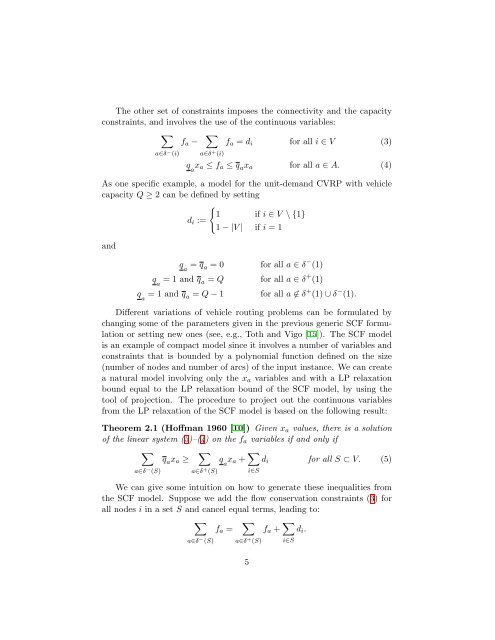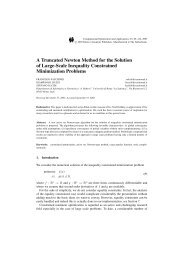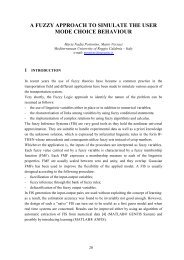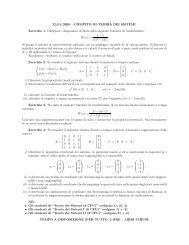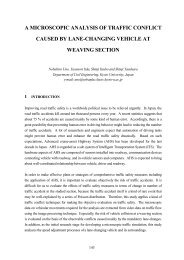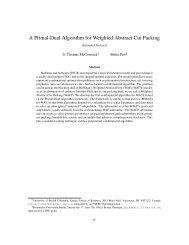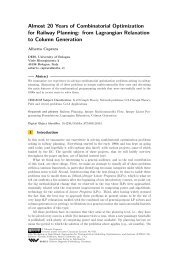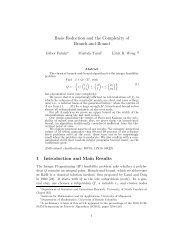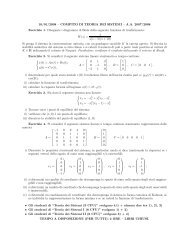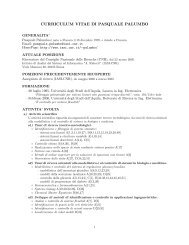Reverse Multistar Inequalities and Vehicle Routing ... - IASI-CNR
Reverse Multistar Inequalities and Vehicle Routing ... - IASI-CNR
Reverse Multistar Inequalities and Vehicle Routing ... - IASI-CNR
Create successful ePaper yourself
Turn your PDF publications into a flip-book with our unique Google optimized e-Paper software.
The other set of constraints imposes the connectivity <strong>and</strong> the capacity<br />
constraints, <strong>and</strong> involves the use of the continuous variables:<br />
<br />
fa − <br />
fa = di for all i ∈ V (3)<br />
a∈δ − (i)<br />
a∈δ + (i)<br />
q a xa ≤ fa ≤ q axa for all a ∈ A. (4)<br />
As one specific example, a model for the unit-dem<strong>and</strong> CVRP with vehicle<br />
capacity Q ≥ 2 can be defined by setting<br />
<br />
1 if i ∈ V \ {1}<br />
di :=<br />
1 − |V | if i = 1<br />
<strong>and</strong><br />
q a = q a = 0 for all a ∈ δ − (1)<br />
q a = 1 <strong>and</strong> q a = Q for all a ∈ δ + (1)<br />
q a = 1 <strong>and</strong> q a = Q − 1 for all a ∈ δ + (1) ∪ δ − (1).<br />
Different variations of vehicle routing problems can be formulated by<br />
changing some of the parameters given in the previous generic SCF formulation<br />
or setting new ones (see, e.g., Toth <strong>and</strong> Vigo [15]). The SCF model<br />
is an example of compact model since it involves a number of variables <strong>and</strong><br />
constraints that is bounded by a polynomial function defined on the size<br />
(number of nodes <strong>and</strong> number of arcs) of the input instance. We can create<br />
a natural model involving only the xa variables <strong>and</strong> with a LP relaxation<br />
bound equal to the LP relaxation bound of the SCF model, by using the<br />
tool of projection. The procedure to project out the continuous variables<br />
from the LP relaxation of the SCF model is based on the following result:<br />
Theorem 2.1 (Hoffman 1960 [10]) Given xa values, there is a solution<br />
of the linear system (3)–(4) on the fa variables if <strong>and</strong> only if<br />
<br />
a∈δ − (S)<br />
q axa ≥ <br />
a∈δ + (S)<br />
q xa +<br />
a <br />
di for all S ⊂ V. (5)<br />
We can give some intuition on how to generate these inequalities from<br />
the SCF model. Suppose we add the flow conservation constraints (3) for<br />
all nodes i in a set S <strong>and</strong> cancel equal terms, leading to:<br />
<br />
fa = <br />
fa + <br />
di.<br />
a∈δ − (S)<br />
i∈S<br />
a∈δ + (S)<br />
5<br />
i∈S


